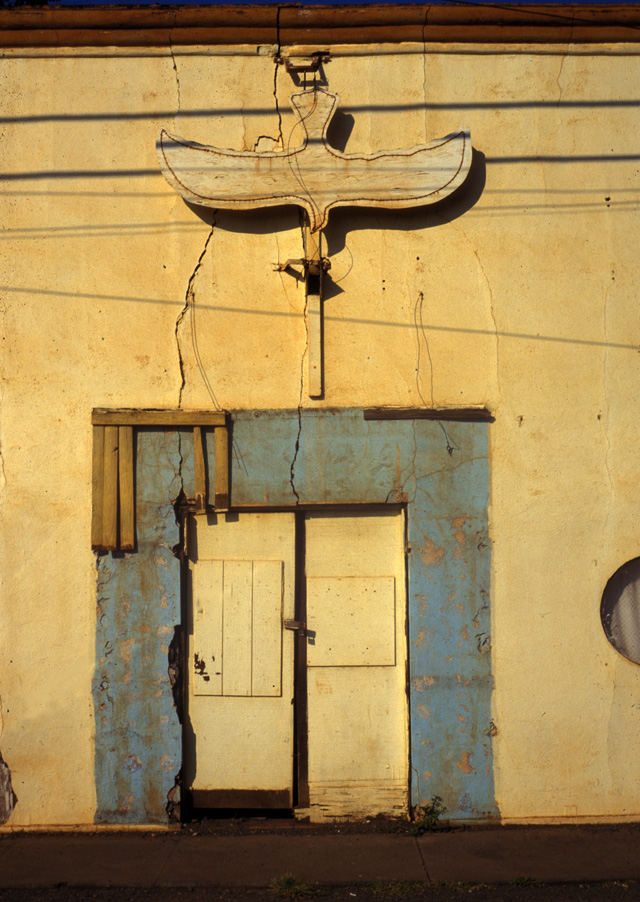John Kerry and George Bush are contending for the hearts and minds of America’s electorate. But that battle also has its regional dimension, with some general divisions of support from the urban-cosmopolitan voters for (Francophone, wine-drinking) Kerry, and the hinterlands and small towns for (somewhat illiterate, phony down-homey) Bush. To some extent the reflect a rift in the American cultural identity between the big city and the small town.

The Paraclete watches over a derelict small-town church in Haliewa, Hawaii ©2004 UrbisMedia
Pearl, MI, West Paduka, KY, Stamps, AK, and most recently, Jonesboro AK. They’re not the names of places one might form an immediate association with urban violence and mayhem. Not like the Bronx, East LA and Chicago’s southside, those notorious big city battle zones. Not places where one might become the victim of a random act of homicide.
They’re small towns; places we might never know existed were they not thrust into the klieg lights of national media by events that are out of character with our impressions of the cherished American Small Town. Small towns are only supposed to make the front pages of big metropolitan newspapers and lead national newscasts when Miss Podunk wins the Miss American Pageant, or a bunch of kids from a wide spot in a two-lane highway sweep the Little League World Series. Not when two young boys who ought to be practicing their hitting and fielding are instead taking target practice on their schoolmates with automatic weapons.
After all, the idea is still very much alive that the essence of America is not in the metropolis, but in the idealized small town: an almost utopian preserve composed of Andy Hardy type kids playing happily on elm-lined streets with white picket fences. The ideal small town has little red school houses, town squares with band gazebos, the requisite general store and Protestant generic clapboard church. Everybody knows everybody (perhaps a little too well). It’s the polar opposite of a menagerie of social marginals in a sea of cosmopolitan urban anonymity. There are, in addition, the cast of small town social archetypes: the pastor, the school marm, a town drunk and town floozie, the two old maid sisters who live in the big Victorian house on Elm street, the sheriff, the publisher of the Elmtown Gazette, and, a chorus of solid, small town families knitted together by unshakable allegiance to the Bible, the Flag, and romantic-familism.
There’s a host of people to whom we can credit these images: regionalist painters, Samuel Clemens, sociologists of the early Chicago School, Norman Rockwell,and Frank Capra films, among others. They have been effective images; surprisingly large percentages of Americans still say they feel that small towns are the best places to live and to raise kids. Many a suburban development and what has been called ‘neo-traditional’ community planning try to market those images to the urban-disaffected.
But more and more, such places exist (maybe only ever existed) in the nostalgia-misted recesses of the American mind. There is the occasional of a revival of a small town here and there, fueled by disenchanted brokers and executives emigrating from the hyper-urbanism of New York or Chicago to oppidan retreats in Vermont or Oregon in search of the grail of American small town life. But the demographics soundly demonstrate that for most of us the metropolis is the habitat if not always of choice, at least of necessity.
These days the ‘dark side’ of the American small town, that side of it that has seeped out in the writings of Tenessee Williams, Faulkner, and Capote, in those black and white newsreels from the early days of racial integration in southern small towns, and in films like In the Heat of the Nigh, Easy Rider, and Mississippi Burning , is formulating a counter-image.
The rhapsodized reputation of the American small town has been tarnished by the same sources of myth-making that exalted it, and administered a coup de grace by school kids with automatic weapons.Today, when we assay this bedrock of American idealism we find it adulterated with a mixture of myth, reality and revenge. The same mass media that gave us the idyllic small towns of Any Hardy and the Waltons has also fed our imaginations on a staple of Peyton Placeand the generic small Southern towns of mean-spirited, bigoted, xenophobic, reactionaries. Andy Hardy has grown up to lead a gang of unemployed, sexually-frustrated, small town punks ready to commit atrocities on any alien they can chase down in their gun-racked pickups. And it is unlikely that they would be deterred by the obese, cigar-munching sheriff who is blinded by his mirrored sunglasses to any malfeasance he can’t snare in his speed trap.
Maybe this negative imagery has come about in the same way as the idealized myth of small towns because the small town has failed to live up to its mythology as the American Promised Land. After all, if Elmtown turns out to be a dreadful place, then there is indeed no place with those “old-fashioned American values.”
Cnservative politicians, xenophobic law enforcement and gun-toting citizens can’t keep out exposure to non-small towns values. TV, films, CD’s and the Internet have woven the small town into the metropolitan, even global, fabric as surely as if a gay and lesbian contingent joined the Fourth of July parade down Elm Street and heavy metal rockers took over the band gazebo. Once July connects to the Internet she and Todo are surely not in Kansas anymore.
But small towns will likely, if only in mythic form, remain a bastion against the evil forces of modernism. They are our cultural innocence, our national virginity, and no matter how cosmopolitan we become, there will probably always be, if only in our imaginations, a small town somewhere in each of us.
___________________________________
©2004, James A. Clapp (UrbisMedia Ltd. Pub. 10.26.2004)
